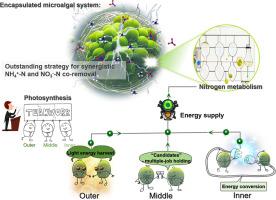包封微藻层间光代谢专门化:废水同步多氮消除策略
IF 12.4
1区 环境科学与生态学
Q1 ENGINEERING, ENVIRONMENTAL
引用次数: 0
摘要
传统的污水处理系统在同时去除氨(NH4+-N)和硝酸盐(NO3——N)方面面临着持续的挑战,这是由于底物竞争和能源密集型的多阶段处理。本研究提出了一种创新策略,利用封装的微藻系统,通过光合能量分配的空间重编程,在单个反应器内实现94.45%的NH4+-N和98.47%的NO3——N同步去除。通过利用藻酸盐包裹的微球内部的结构异质性,形成了深度分层的代谢区,挑战了微藻固有的NH4+-N偏好的长期教条。包括空间分布图、分子动力学模拟、宏基因组分析和光合调节在内的多维分析进一步揭示,光调节的氧梯度、聚合物介导的溶质运输和分层光代谢专门化协同重新编程了微藻的氮代谢,使NH4+-N和NO3——N能够共同利用。该系统在不同的环境条件下表现出强大的双氮同化效率,超越了传统的底物利用层次。这种变革性的方法不仅解决了混合氮污染的困境,而且通过将污染物去除与生物质增值相结合,推进了可持续污水处理。这些发现为微藻代谢可塑性提供了机制见解,并为传统反硝化技术的升级提供了可扩展的节能解决方案,符合水资源管理中循环经济的迫切需求。本文章由计算机程序翻译,如有差异,请以英文原文为准。

Layer-specific photo-metabolic specialization of encapsulated microalgae: A strategy for synchronous multi-nitrogen elimination from wastewater
Conventional wastewater treatment (WWT) systems face persistent challenges in simultaneous ammonium (NH4+-N) and nitrate (NO3--N) removal due to substrate competition and energy-intensive multi-stage processes. This study presents an innovative strategy leveraging encapsulated microalgal systems to achieve synchronous 94.45% NH4+-N and 98.47% NO3--N removal within a single reactor through spatial reprogramming of photosynthetic energy allocation. By exploiting the structural heterogeneity within alginate-encapsulated beads, depth-stratified metabolic zones were created that challenge the long-held dogma of microalgae’s inherent NH4+-N preference. Multidimensional analyses, including spatial distribution mapping, molecular dynamics simulations, metagenomic profiling and photosynthetic regulation, further revealed that light-modulated oxygen gradients, polymer-mediated solute transport, and stratified photo-metabolic specialization synergistically reprogramed microalgal nitrogen metabolism, enabling co-utilization of NH4+-N and NO3--N. The system demonstrated robust dual-nitrogen assimilation efficiencies under varying environmental conditions, transcending conventional substrate utilization hierarchies. This transformative approach not only resolves the dilemma of mixed nitrogen pollution but also advances sustainable WWT by integrating pollutant removal with biomass valorization. The findings provide mechanistic insights into microalgal metabolic plasticity and offer a scalable, energy-efficient solution to upgrade traditional denitrification technologies, aligning with urgent demands for circular economy in water resource management.
求助全文
通过发布文献求助,成功后即可免费获取论文全文。
去求助
来源期刊

Water Research
环境科学-工程:环境
CiteScore
20.80
自引率
9.40%
发文量
1307
审稿时长
38 days
期刊介绍:
Water Research, along with its open access companion journal Water Research X, serves as a platform for publishing original research papers covering various aspects of the science and technology related to the anthropogenic water cycle, water quality, and its management worldwide. The audience targeted by the journal comprises biologists, chemical engineers, chemists, civil engineers, environmental engineers, limnologists, and microbiologists. The scope of the journal include:
•Treatment processes for water and wastewaters (municipal, agricultural, industrial, and on-site treatment), including resource recovery and residuals management;
•Urban hydrology including sewer systems, stormwater management, and green infrastructure;
•Drinking water treatment and distribution;
•Potable and non-potable water reuse;
•Sanitation, public health, and risk assessment;
•Anaerobic digestion, solid and hazardous waste management, including source characterization and the effects and control of leachates and gaseous emissions;
•Contaminants (chemical, microbial, anthropogenic particles such as nanoparticles or microplastics) and related water quality sensing, monitoring, fate, and assessment;
•Anthropogenic impacts on inland, tidal, coastal and urban waters, focusing on surface and ground waters, and point and non-point sources of pollution;
•Environmental restoration, linked to surface water, groundwater and groundwater remediation;
•Analysis of the interfaces between sediments and water, and between water and atmosphere, focusing specifically on anthropogenic impacts;
•Mathematical modelling, systems analysis, machine learning, and beneficial use of big data related to the anthropogenic water cycle;
•Socio-economic, policy, and regulations studies.
 求助内容:
求助内容: 应助结果提醒方式:
应助结果提醒方式:


